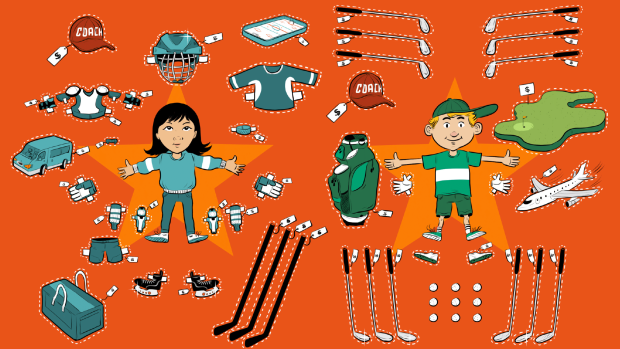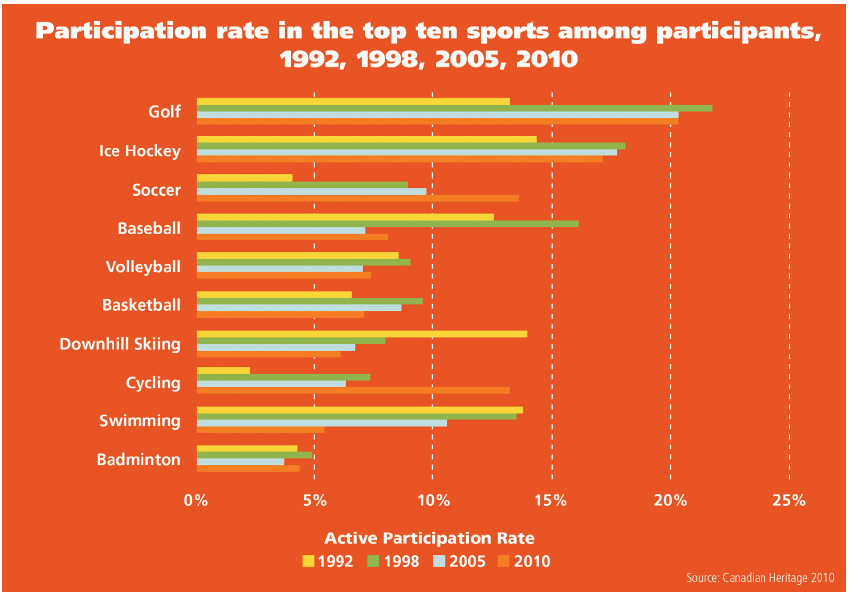Sep 18, 2019
MoneyTalk: A Run For Your Money
Presented by:

, BNN Bloomberg

When Junior scores a hat trick, everyone gets excited: Junior, the parents, teammates, the coach, and suddenly, visions of Junior in a major league uniform appears. But raising an elite athlete can be an expensive investment, and one that may not have any financial return. Here are some typical costs to raise an athlete, so you can decide whether to get the ball rolling.
If there are two people that know what it takes to be an elite athlete, it’s Paul Poirier and Piper Gilles. Paul and Piper, both 25 — four time Canadian medalists in ice dancing — are training hard and on course to dance their way to the 2018 Olympics. Between ice time, costumes, and coaching, both them and their parents have spent a small fortune on the sport.
“My parents would never tell me an exact number,” says Paul, “but I would imagine it to be enough to buy another house at this point.”
Piper agrees, and adds, “…a really nice house!”
But despite the cost of custom figure skates and travel to competitions around the world, both agree that while it can be very expensive to raise an elite athlete, money doesn’t guarantee success.
“Money can’t buy hard work, sacrifice, and dedication,” says Piper.
“More money can definitely buy more training opportunities,” says Paul, “but these don’t necessarily translate to results.”
“Money can’t buy hard work, sacrifice, and dedication”
- Piper Gilles, Canadian ice dancer
But try telling that to parents who have just seen their son or daughter get the MVP award at the sports banquet. Often what starts out as recreational “house-league” play can quickly turn to ultra-competitive “rep-league” elite teams, expensive training and development opportunities in the offseason. Many parents just want to see their children reach their full potential, but some will readily admit they see the promise of a top university scholarships, and potentially professional careers and endorsement deals.

The First Stage of the Game: Organized Sports
According to the Canadian Lifestyle and Fitness Research Institute, 77 per cent of 5 to 19-year-olds participate in organized physical activities or sport. Youth sports represent a $5.7 billion market with families spending an average of nearly $1,000 annually per child on sports.1
According to the Youth Sports Report, popular team sports such as basketball, volleyball and soccer cost 25 to 50 per cent less than the average, while hockey came in as the second most expensive of all sports studied. The top three most expensive sports to participate in for youth, based on reported average annual spending, were water skiing ($2,028), hockey ($1,666) and equestrian ($1,434). At the other end of the spectrum, the most affordable options were track & field ($226) and cycling ($237). Those costs include expenditures on equipment, fees for leagues, and any transportation costs.2
Getting kids involved in sports at any level has benefits that can far outweigh the financial costs. Beyond fitness, studies show that physical activity and academic success are strongly correlated. Sports have also been shown to have a positive effect on behaviour in children.3 But as parents spend more and more money on high-performance teams and expensive development opportunities, is there a point where the costs outweigh the benefits?
Overtime and Overspending: The Next Level
Paul suggests that parents encourage well-rounded sports play for as long as possible, instead of rushing their children to specialize and advance in a specific sport. “I think the most important thing is not to let your kid specialize too early,” he says. “Kids who develop many different skills through different sports are more rounded athletes and are less likely to be injured down the road.”
But, if you are certain that your child has a future in one sport and encourage them to specialize, understand that it is a big financial commitment. Of course different sports will have different costs involved, but at a high performance level, none are cheap. Chris Chard, an associate professor at Brock University’s Sport Management program estimates that players who want to train at an elite level can look forward to costs that can easily approach $15,000 per year depending on the sport, and that is for only one child. A family with athletic genes could spend much more than that. Chard has an eight-year old that is just starting out in competitive swimming plus two teenagers in rep hockey and is dealing with cost issues himself.
“It may not even be the costs directly related to play that will set parents back the most,” he says. “It’s actually the little things, like mileage and gas used driving thousands of kilometers to tournaments. Equipment can also be a very expensive part of the cost.”
He says that his sons can go through three or four $300 hockey sticks each in one season. He also suggests that parents face peer pressure to buy the “premium” equipment for their child, assuming that a premium shoe or skate, for example, may increase performance exponentially.
“This is a tricky question,” says Paul about investing in premium equipment for an athlete. “I think the best time to invest in premium equipment is when you feel the lower-grade equipment is impeding the athlete from achieving their best, and is breaking down too quickly, because the athlete is training so much.”
Piper suggests that a good option for parents to decide whether to invest in premium equipment is to try out “gently used” if possible. You might get a sense of how your child likes the equipment and plays with it, before purchasing brand-new.
“It may not even be the costs directly related to play that will set parents back the most. It’s actually the little things…”
- Chris Chard, Sports Management Professor, Brock University
High performance athletes compete against other high-level athletes, and that often means travelling far distances, or internationally. Believe it or not, even if you are competing for Team Canada, much of the costs of getting to an international competition may not be covered or subsidized, which means parents and athletes must get themselves there on their own dime. Even if the athlete’s travel expenses are covered, proud parents hoping to take in the games in-person will have to find their own way there. It is not unusual that Canadian parents with a child competing in the Olympics have no choice but to watch them compete on television at home.
Know the Score about Scams
Where there are starry-eyed parents, you can be sure there are scams. Parents need to keep a level-head about the products and services they purchase when trying to give their child an advantage.
Research the clubs and coaches you work with, as both should have accreditation. Talk to others to find out if camps, trainers, and programs are known, and respected.
“I think the most important thing is to always seek out more than one opinion,” says Paul. “Try to speak to your sport’s governing body as well as to parents with children older than yours who are more familiar with the landscape of the sport.”
Some sports scholarship recruiting services promise to help your children obtain scholarships in the U.S., because they claim they have access to important people and insider information that you don’t. They charge thousands of dollars to put your child in their database and connect your athlete with college scouts. But there are no shortcuts to obtaining a sport scholarship at a reputable school. And in fact, some of these services may hurt your chances of being recruited, as they may not be well-respected among college recruiters. So do your research early and prepare accordingly if you wish to pursue the scholarship route.
Many other common scams targeting parents of athletes are widely reported on the internet by parents who feel they’ve been duped. They involve publications which promise to write feature stories on your child for a price, or threaten bad reviews if you don’t pay them money. Showcases or events which promise to bring renowned and high-level recruiters to watch your child play for a large registration fee should be approached with caution.
Have a Financial Game Plan
Chris Gandhu, High Net Worth Planner at TD Wealth, is just learning what it means to be a parent with a child in competitive sports. His six-year-old son is just embarking on a competitive gymnastics career, and so he’s going to learn, in short order, to put his money management knowledge to good use.
Chris says that while the expenses can become overwhelming for a parent, some good planning can help to ensure you work within your cash flow.
“Consider pooling resources with other parents,” says Chris. “Carpool to tournaments, or share the responsibility of chaperoning the team. If hiring a trainer or coach, share sessions with other players to reduce the cost.”
$15K
$15,000 per year: The estimated cost for one child, per year, in high-level sports.4
Chris also says that the power of fundraising can’t be underestimated. “No one likes to be hit up for donations constantly, but finding a way to fundraise for the team that is fun and effective can really offset costs. In the same vein, crowdfunding, raising money from large groups of people on websites like Indiegogo or Kickstarter, is becoming increasingly popular for sports teams.”
And just like any life goal, financial planning is important, he says. Work with a financial professional who can help you save and invest to help fund your child’s activities. If you and your child are committed to pursuing a career in sport, or simply pursue athletic excellence at the highest level, factor the costs of this journey and goal into your budget, in both the short and long term.
Paul says that many parents might get ahead of themselves and not even consider whether their child has an enjoyment of the sport, and might be biased when it comes to their child’s ability.
“Get many educated opinions about your child’s ability and the training requirements needed to reach the next level,” he suggests, “and make sure to also ask those who have no vested interest in making more money from you.”
Piper says to support your child throughout, and remember that sport is less about a future job, and more about life lessons.
“Just be knowledgeable about everything you are investing in and make sure your child loves it because at the end of the day, sports are hard. They will test you, but that love will carry them to great heights and give you experiences that no money can buy.”
1 Canadian Fitness and Lifestyle Research Institute. “Kids Can Play.” 2015. Accessed May 30, 2017
2 Solutions Research Group Consultants. “Youth Sports Report.” 2014. Accessed May 30, 2017.
3 The Aspen Institute. “Facts: Sports Activity and Children.” Accessed June 6, 2017
4 Chris Chard, Brock University









